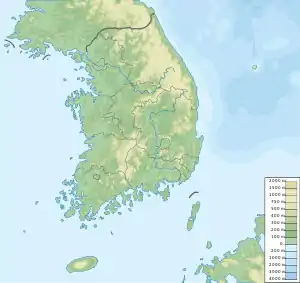.svg.png.webp) Magnitude of 2016 Gyeongju earthquake | |
 | |
 | |
| UTC time | 2016-09-12 11:32:54 |
|---|---|
| ISC event | 609440121 |
| USGS-ANSS | ComCat |
| Local date | September 12, 2016 |
| Local time | 20:32:54 KST |
| Magnitude |
|
| Depth | 13 kilometers (8.1 mi)[1] |
| Type | Strike-slip |
| Areas affected | South Korea |
| Max. intensity | VI (Strong) |
| Tsunami | No |
| Landslides | No |
| Foreshocks | ML 5.1 (19:44, September 12, 2016) |
| Casualties | 8 injured |
The 2016 Gyeongju earthquake occurred on September 12 near Gyeongju, South Korea.[1] Measuring 5.8 on the local magnitude scale (5.4 Mw), it was the strongest earthquake in the country[2][3] until the following year. The 2017 Pohang earthquake caused more damage despite being equal in magnitude. An hour before, at 07:44:32 local time, a ML 5.1 foreshock occurred.
See also
References
- 1 2 3 "M5.4 - 6km S of Kyonju, South Korea". United States Geological Survey. September 12, 2016. Retrieved September 12, 2016.
- ↑ "Strongest-ever earthquake hits Korea, tremors felt nationwide". The Korea Times. September 12, 2016. Retrieved 2016-09-13.
- ↑ "S. Korea still presumed safe from major earthquakes: experts". The Korea Herald. September 12, 2016. Retrieved 2016-09-13.
External links
- The International Seismological Centre has a bibliography and/or authoritative data for this event.
35°46′08″N 129°13′37″E / 35.7690°N 129.2270°E
This article is issued from Wikipedia. The text is licensed under Creative Commons - Attribution - Sharealike. Additional terms may apply for the media files.